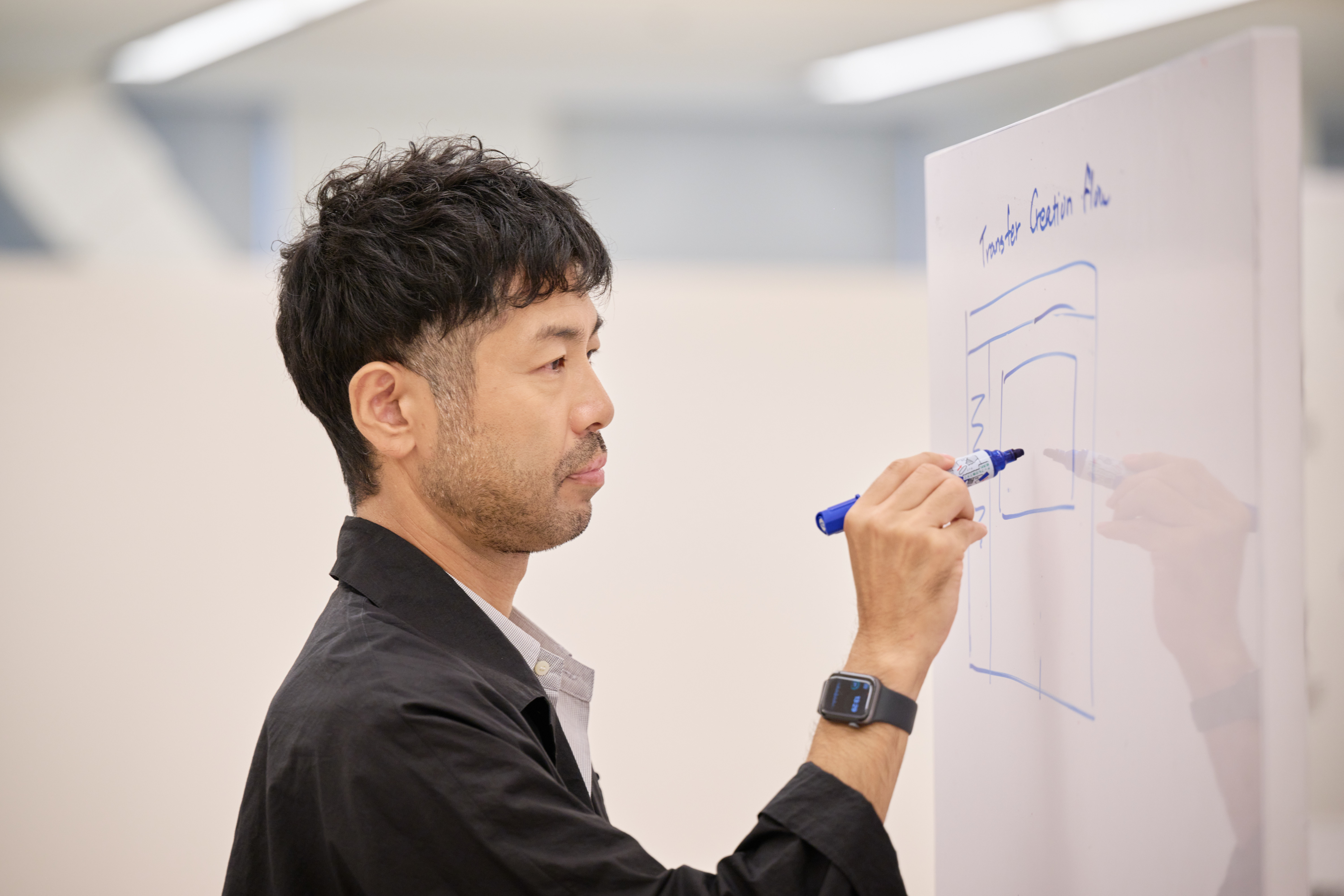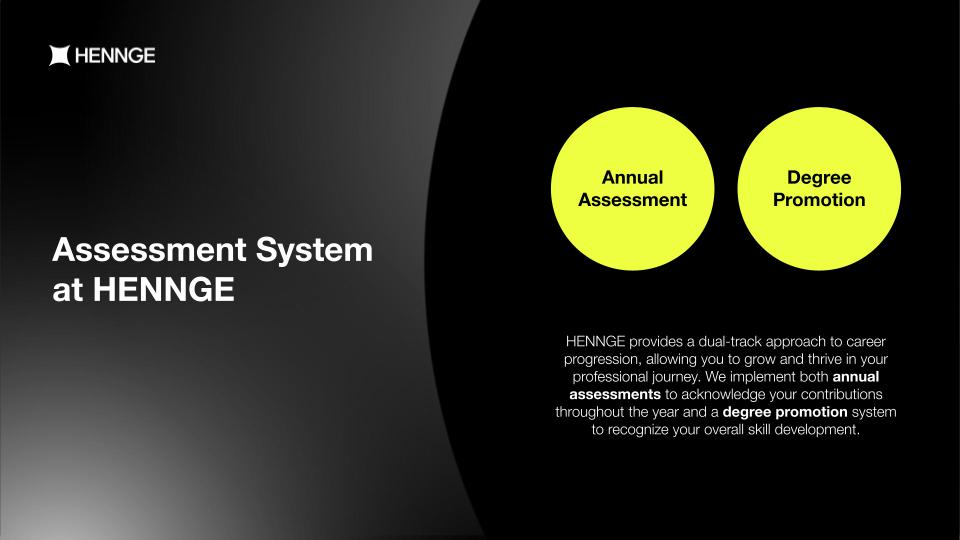

CEL OGIYA
Published on September 26, 2025
Ever wondered how employee assessments are done at HENNGE? We believe in fostering our team’s growth and development, and our performance evaluations are a key part of this process. These evaluations help managers identify top performers and empower members to reach the next level in their careers.
HENNGE champions a merit-based approach, where career progression is driven by individual performance. Employees with the right skills and motivation can aim higher, regardless of age or tenure with the company. Exceptional performance is nurtured through ongoing growth and consistent effort, not just single achievements.
HENNGE’s degree promotion and annual assessment process recognize and honor employees’ contributions while aligning with the HENNGE Way—our core values and guiding principles. At HENNGE, golden opportunities and silver linings are within reach for those who go the distance.
Employee performance reviews are more than just periodic check-ins. They’re a valuable opportunity to assess an employee’s effectiveness and the impact of their contributions to the organization’s success. Reviews also help ensure that personal aspirations are in sync with team goals, creating a shared sense of purpose and collective success.
Performance evaluations allow managers and decision-makers to highlight individual strengths, pinpoint areas for growth, and determine whether specific targets have been fulfilled. In addition, these evaluations celebrate outstanding contributions. Employees feel valued and appreciated for their hard work through promotions, bonuses, and other career development opportunities.
HENNGE follows a dual-track approach to career progression. Its annual assessment review acknowledges and evaluates an employee’s accomplishments and contributions throughout the year. Evaluators provide constructive feedback and guidance to support continued development.

Simultaneously, HENNGE’s degree promotion system focuses on recognizing skill development and identifying opportunities for advancement. This system also supports fair compensation by adjusting salary ranges according to market standards.
HENNGE’s Annual Assessment Process
The annual assessment process at HENNGE is similar to the yearly evaluation called nenji hyouka (年次評価) or nenji satei (年次査定) done in many Japanese companies. Similar to other annual performance reviews, employees and managers use the SMART criteria (Specific, Measurable, Achievable, Relevant, and Time-bound) to set goals, reflect on the previous assessment evaluation, and establish clear objectives for the future.
“At HENNGE, goal-setting has two main components: how each team member can contribute to their team’s objectives, and how they can grow personally within that framework, which will be reflected in their degree promotion evaluation. Essentially, goals represent the outcomes they want to achieve, actions are the steps they take to reach the desired outcomes, and focus areas are the key priorities they want to work on.
“Before setting their goals, team members are encouraged to discuss with their manager or supervisor to clarify how their achievements will be measured. This helps ensure everyone is on the same page and makes the annual assessment process smoother and more effective,” explains Toshihiro Takasu, Executive Officer of the People Division.
HENNGE’s annual assessment process has three key steps: setting goals, reviewing progress, and evaluating the results. During the first half of the fiscal year, goals are set, and progress is reviewed. Next, new goals are established for the second half of the year, followed by a progress review. The process concludes with a final evaluation of the annual performance for the fiscal year.
If an employee is promoted to the next belt during the annual assessment, their new salary range will be determined based on the experience points they have accumulated in comparison to others at the same belt level. The subrank, which refers to the performance meter attached to the belt order, reflects an employee’s progress at their current belt level. It determines the specific salary within the belt’s range, ensuring that pay adjustments are fair and accurately reflect each individual’s experience and development within the company.
Career Advancement at HENNGE Through Degree Promotion
Traditionally, one of the fundamental aspects of job promotion in Japan is shanai shoshin (社内昇進), a seniority-based internal wage and promotion system. Under this system, an employee’s base pay is increased periodically based on the length of service, or kinzoku nensu (勤続年数), and age.
In recent years, many Japanese companies have shifted toward a performance-driven model, where promotions and rewards hinge on individual achievements and contributions rather than seniority. A performance-based compensation method is closely tied to setting and achieving personal goals that resonate with the team’s overall objectives.
So, how does a member move up the ranks or get promoted at HENNGE? For a fair and transparent process, HENNGE adopts a proactive, application-based approach focused on performance instead of relying on the traditional passive, promotion-based system. During the Degree Promotion Examination—a mid-term recognition process that includes a corresponding salary range—evaluators review past performance and historical evidence to determine if an employee meets the criteria for advancing to the next belt level.
The Belt System
HENNGE’s belt system defines the skills and experience requirements for each role or job type. The company has seven degree classifications, each corresponding to a different set of responsibilities and level of expertise:
- Platinum Belt
- Gold Belt
- Silver Belt
- Bronze Belt
- Brown Belt
- Green Belt
- White Belt
HENNGE has a structured career progression framework for non-engineering positions, with a tiered belt system that clearly outlines job expectations at each level. Team members at the White (fresh graduates or entry-level professionals), Green (junior member level), and Brown (senior member level) belt orders mainly focus on fulfilling the needs and demands of their respective sections or departments.
As employees move into higher leadership roles at the Bronze (leader or manager level) and Silver (senior leader or senior manager level) belt orders, they are expected to contribute directly to company-wide strategic goals. Gold (department leader level) and Platinum (executive officer level) belt orders are reserved for HENNGE’s leading experts and industry innovators, who play a pivotal role in driving the company’s strategic vision and shaping its future growth.
“Someone with a Gold Belt who wants to advance to Platinum must satisfy the specific criteria for that particular belt level. This could include delivering keynote speeches at major conferences, writing a book on technology as the sole author, or taking on a leadership role within the community,” Takasu says.
Dual Career Paths for Engineers
HENNGE offers a dual career path for specialized engineering positions, allowing engineers to forge their own road to success. The management track is designed for those passionate about leading teams, overseeing projects, and mentoring others. Alternatively, engineers who want to deepen their expertise in specific technologies may pursue a technical track where they can refine their skills, amplify their scope of responsibilities, and make a greater impact without transitioning into supervisory roles. Employees may apply to advance to a higher belt order, which comes with an expanded salary range, by presenting evidence of their achievements.
Managers or immediate supervisors play a crucial role in verifying the accuracy and integrity of application materials before the degree promotion examination. While applicants diligently compile evidence to demonstrate their skills and qualifications for belt promotion, supervisors carefully check the legitimacy and reliability of the information provided. Aside from offering feedback on how well an employee has demonstrated their capabilities, they are also expected to support an individual’s future career development.
The Evaluation Process
In addition to the applicant’s manager or immediate supervisor, the degree promotion examination also includes four or more assessors from the higher belt the applicant seeks to be promoted to. These assessors, who may not hold supervisory roles, provide objective evaluations of the applicant’s achievements and offer recommendations to the presiding executive officer on whether the applicant is deemed suitable for promotion.
Evaluating an employee’s ability takes time and careful consideration. It can be challenging to measure skills and performance objectively, as subjective factors like personal opinions, varying job expectations, and team dynamics inevitably influence the process. When an employee feels ready to apply for a higher belt ranking, a vital step is initiating a candid conversation with their manager or immediate supervisor. This provides valuable feedback on how their colleagues and superiors view their work and readiness for promotion.
Are you ready to level up your career and showcase your value? See our job openings here and rise through the ranks by sharpening your skills and building your expertise. At HENNGE, everyone deserves a fair shot and a slice of the success pie, regardless of seniority or tenure.